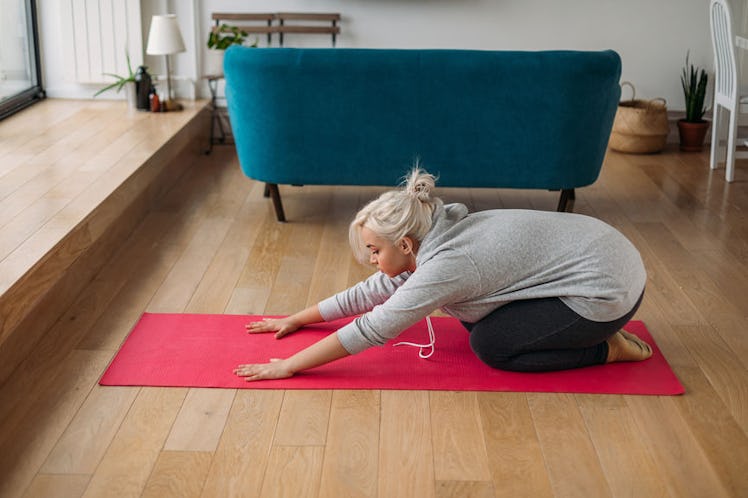
A Yoga Teacher Reveals How Long Your Practice Should Be When You're Flowing At Home
The beauty of being a yogi who practices at home is that some days, your practice is five minutes long, and others, it's nearly an hour — and that's totally cool. When you're not in an actual studio, and you're flowing freely without instruction, there's a lot more flexibility in terms of how long you remain on your mat. You get to decide how long your yoga session is; but with that freedom can come a bit of confusion and self-doubt. Maybe you find yourself continuing to flow into pose after pose, simply because you feel like you "should," or because 20 minutes didn't feel "long enough." So what's a yogi to do? Is there really a magic timeframe you should be aiming for in your practice? Or should you ~literally~ go with the flow?
Though there's no yogic handbook detailing the designated length you should make your practice in order for it to "work" (whatever that means), Sara DiVello, a nationally recognized yoga and meditation teacher and author of the book Where in the OM Am I?, tells Elite Daily that she's no stranger to feeling obligated to remain on her mat for a certain amount of time.
Back when she was a yoga newbie, DiVello tells me, she thought a typical flow "should" be 90 minutes, and that it "had" to be in a studio or a gym, "because that was the length and location [for] the Ashtanga classes I took," she explains.
In other words, practicing yoga for a shorter duration at home essentially didn't count in DiVello's book. For some of you yogis, this might sound all too relatable.
"About five years into practicing yoga, I started to do some yoga at home — but I stuck to the 90-minute format, and the flow looked a whole lot like every single class I'd ever taken (standing, strength-based postures to seated postures, forward-bending, back-bending, must attempt an inversion, down to seated, reclining, and finally savasana)," she recalls.
The problem, according to DiVello, was that she didn't always have 90 minutes to spare for a yoga session, nor did she always feel physically up to it, which makes total sense. Imagine being totally spent after work, or fighting a cold, or trying to enjoy weekend plans with friends, or just simply feeling tired as hell — what should be a relaxing yoga flow that centers your mind and body, quickly becomes an intense and exhausting task to check off your to-do list.
"One day I realized how rigid I was being mentally, while doing a physical practice meant to limber me up — oh, sweet, sweet irony," DiVello explains. "Once I got mentally flexible on what yoga 'should' look like, it got a whole lot more fun and it fit my lifestyle better — which meant I was actually doing it more."
Now, DiVello says, while her yoga practice might be just 15 minutes long on some days, that's what works best for her body and her lifestyle — and that's what she recommends as a teacher to her fellow yogis.
"[Now my practice] probably only includes the poses I need that day — it may consist of only pranayama (breathing exercises) or meditation," DiVello tells Elite Daily. "And guess what? It's just perfect exactly as it is."
DiVello tells me that she encourages all of her students to be mentally flexible as they think about and engage with their practice, because ultimately, she says, that's what's going to keep you on your mat and help you tailor your practice to exactly what you need on any given day. And isn't that what yoga's supposed to be all about anyway?